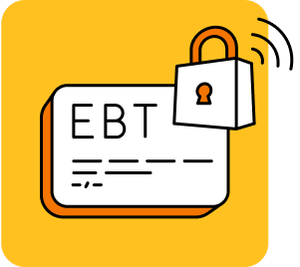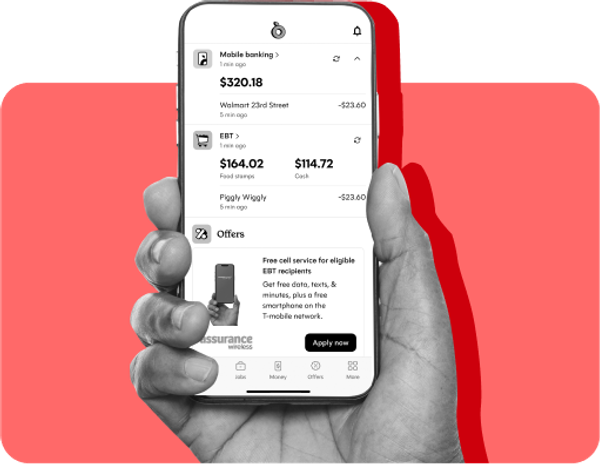Is TANF the same as food stamps?

No, TANF and food stamps are two different things. While both programs support lower-income families, TANF (cash assistance) and SNAP (food benefits) serve different purposes and have separate rules.
People sometimes mix up these programs because they're often talked about together and they both use EBT (Electronic Benefits Transfer) cards for benefits delivery. Let's clear up the confusion:
- SNAP, also called food stamps, offers money specifically for food assistance
- TANF, sometimes called Cash EBT or welfare, provides cash for essential needs beyond food and groceries, like help with rent or childcare
- Both involve EBT cards, but that’s just the payment method, not a program itself
What are the differences between TANF and SNAP?#what-are-the-differences-between-tanf-and-snap
TANF and SNAP are separate programs that differ in several important ways:
| TANF | SNAP | |
|---|---|---|
| What you get | Cash to spend on life essentials, like rent, diapers, and daycare | Food benefits for groceries only (though you may be surprised to find out what you can buy!) |
| Time limits | Usually capped at 5 years in total | Continues as long as you qualify; time limits only apply to able-bodied adults without dependents who aren’t meeting work requirements |
| Who it helps | Primarily families with children | Both individuals and families with kids |
| Work rules | Strict work participation rules for most recipients | Varies based on age, dependents, ability |
| Application process | Often more complex and involves more verification | Usually streamlined |
What is TANF?#what-is-tanf
TANF (Temporary Assistance for Needy Families) is the official name for what many people call welfare or Cash EBT. Created in 1996, this program gives states federal funding to help families with children meet their basic needs. States have flexibility in designing TANF programs, but it typically offers:
- Monthly cash payments loaded onto an EBT card
- Job training opportunities
- Child care support
- Transportation help
While TANF offers immediate help during difficult times, it aims to build pathways toward financial independence. That's why most states limit lifetime benefits to five years.
How do you qualify for TANF?#how-do-you-qualify-for-tanf
Eligibility rules vary by state, but generally in order to qualify for TANF you need to:
- Live in the state where you apply
- Have legal status in the U.S.
- Have a very limited income (typically below half the median income in your area)
- Have children under 19, be currently pregnant, or being a teen head of household
Something to note: You can't get both TANF and SSI (Supplemental Security Income) at the same time.
TANF recipients usually have to either have a job or be involved in some kind of work-related activity, meaning job training, education programs, or community service.
How to apply for TANF#how-to-apply-for-tanf
The TANF application process varies by state but typically you need to:
- Find your local program: Each state names and runs TANF differently. In some places, it’s called “Temporary Assistance (TA)” and in others it’s called “Family Assistance (FA).”
- Choose how to apply: Your options may include an online portal, an in-person visit, or a mailed paper application.
- Prepare your documents You typically need proof of identity (like a driver’s license or birth certificate), proof of income and assets, housing costs (a rental agreement and utility bills), and your Social Security card, among other paperwork.
- Complete an interview: A caseworker will set up a call with you to verify your information.
- Receive a decision: If you’re approved, you’ll start receiving monthly benefits; if you’re denied, you have appeal rights.
Using TANF benefits#using-tanf-benefits
States set their own TANF spending restrictions but typically allow purchases that support basic needs, like:
- Housing costs, like rent
- Food
- Clothing
- Utilities, like electricity and gas bills
- Child care-related expenses
- Transportation, like a monthly subway or bus passes
- Household necessities like diapers and wipes
There are also rules about what you can’t buy with TANF, including things like alcohol, tobacco, and lottery tickets.
Just like with a SNAP EBT card, you can use mobile apps like Propel to check your cash EBT balance and manage your TANF benefits.

Propel is the #1-rated EBT balance checking app
What is SNAP?#what-is-snap
SNAP, often called food stamps, helps millions of Americans afford groceries. Unlike TANF, it focuses exclusively on food, and you can’t use SNAP benefits on any household items like diapers or toilet paper.
SNAP gives eligible households a monthly benefit amount loaded onto an EBT card. The money you get from SNAP can only be used on eligible groceries, including:
- Fruits and vegetables
- Meat, poultry, and fish
- Dairy products like milk, yogurt, and cheese
- Eggs
- Grains like rice and quinoa
- Bread and cereals
- Snack foods like chips, nuts, popcorn, and chocolate
- Non-alcoholic beverages like juice, milk, and water
- Seeds and plants for growing food at home
You cannot use SNAP to buy prepared hot foods, alcohol, tobacco, vitamins, household supplies, or pet food.
How do you qualify for SNAP?#how-do-you-qualify-for-snap
Like with TANF, you have to apply for SNAP in your state. Eligibility requirements for SNAP include:
- Making below program limits in monthly income (for a single person, that’s typically under $2,510 monthly)
- Having U.S. citizenship or eligible immigration status (refugees may qualify immediately, while permanent residents often have to wait five years)
- Meeting work requirements if you're an able-bodied adult without dependents
Unlike TANF, SNAP doesn't typically consider your assets—owning a home, a car, or having savings generally won't affect your eligibility.
Recent financial changes matter, too. If you've just lost your job, you might be newly qualified.
Even college students can receive SNAP in certain situations, and the program continues as long as you meet the eligibility criteria, without time limits like TANF.
How to apply for SNAP#how-to-apply-for-snap
The SNAP application process varies by state but typically you’ll need to:
- Determine your household size: SNAP defines your household as people you buy and cook food with. You must include your spouse and any children under 22 who live with you, even if you don't share meals.
- Choose how to apply: Your options include your state's online benefits portal, in-person visits to local SNAP offices, mail, or phone applications.
- Prepare your documents: You'll need proof of identity (like a driver's license or birth certificate), income verification (pay stubs), proof of address, and your Social Security Number, among other paperwork.
- Complete an interview: An eligibility worker will conduct a phone interview to verify your information and answer questions about your application.
- Receive a decision: Like with TANF, if you’re approved for SNAP you'll get benefits loaded onto an EBT card; if you’re denied, you have the right to appeal the decision.
Can you qualify for both TANF and SNAP?#can-you-qualify-for-both-tanf-and-snap
Yes, many households qualify for both TANF and SNAP since they target similar (but not identical) needs. TANF often works alongside other support programs like:
- SNAP (food assistance)
- CACFP (Child and Adult Care Food Program)
- Housing assistance
- Medicaid
- Child care subsidies
Your state benefits office can help you determine which programs fit your situation and guide you through applying for multiple forms of assistance.
If you're facing any kind of financial hardship, even if it’s temporary, don't assume you won't qualify for help— contact your local human services agency to learn about available support.








